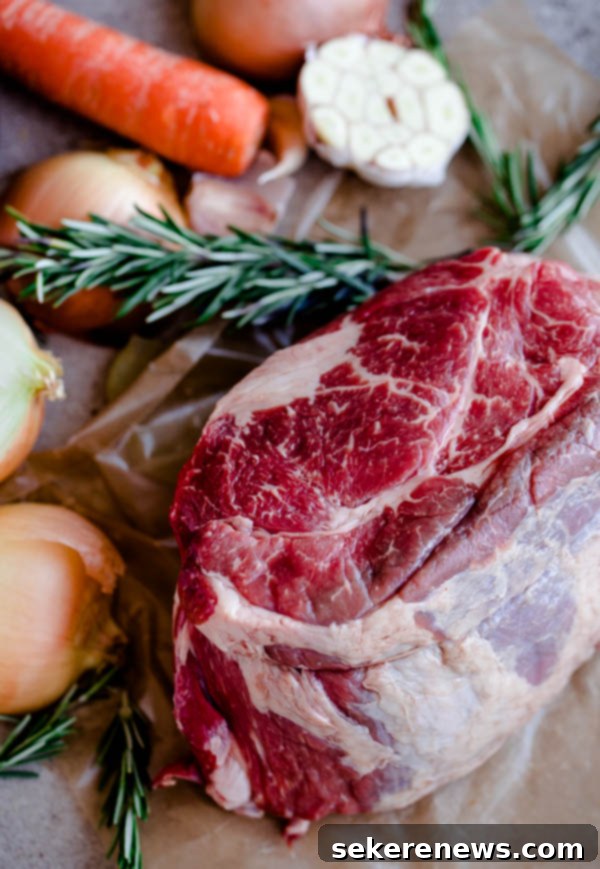Mastering Classic Italian Beef Pot Roast: The Ultimate Stracotto Recipe
Embark on a culinary journey to the heart of Italy with this magnificent Classic Italian Beef Pot Roast, affectionately known as ‘Stracotto‘. This incredibly flavorful and deeply satisfying braised dish is a true testament to the magic of slow cooking, transforming a humble cut of beef into a fork-tender masterpiece infused with rich red wine and aromatic vegetables. The resulting sauce is so robust and savory, it promises a comforting and memorable dining experience, perfect for special occasions or a cozy weekend meal.

The Art of Braising: A Chef’s Secret for Effortless Flavor
There’s a special kind of joy that comes from making braised dishes in the kitchen. They require patience and a bit of foresight, but the process itself is largely hands-off, allowing you to go about your day while a spectacular meal gently simmers to perfection. For me, braising sits proudly at the top of my favorite cooking methods. The anticipation builds as the irresistible aromas fill your home, promising a delicious reward in just a few hours. This hands-off approach also makes braised meals ideal for entertaining – they’re incredibly forgiving and can often be prepared in advance, leaving you free to enjoy your guests.

Decoding Stracotto: More Than Just “Overcooked”
While I don’t prepare pot roasts daily, they hold a special place among my most cherished meals. This particular recipe for Italian beef pot roast, or stracotto, comes from one of my all-time favorite cookbooks: All About Braising: The Art of Uncomplicated Cooking by Molly Stevens. I can honestly say I’ve never been disappointed by a single recipe from this culinary gem. What makes it even better is its comprehensive scope, offering not just classic beef and poultry braises, but also a delightful array of braised seafood and vegetable dishes.
As mentioned, ‘Stracotto’ literally translates to ‘overcooked’ in Italian. This translation, while technically accurate in describing the extended cooking duration, truly undersells the dish. In reality, this slow-cooked beef becomes unbelievably tender, moist, and bursting with layers of flavor. It’s a prime example of how traditional Italian cooking transforms simple ingredients into something extraordinary. And when a recipe calls for an entire bottle of good quality red wine in the cooking process, you know you’re in for something truly spectacular. The wine doesn’t just add liquid; it infuses the meat with a profound depth and complexity that defines this hearty dish.
The Journey to Tenderness: Preparation and Patience

Now, let’s talk about the commitment involved in making this incredible stracotto. I understand that the prospect of a long cooking time and a detailed instruction list might seem daunting at first. However, let me assure you: this is *not* a difficult recipe in terms of technique. Its complexity lies in its timeline, which requires a significant investment of time, but minimal active effort. Unlike a spontaneous weeknight meal, this is a dish you plan for, and the planning itself is part of the experience.
To truly achieve the depth of flavor that defines a perfect Italian pot roast, you’ll need to set aside approximately 24 to 36 hours for marinating the raw beef. This extended marinade time, steeped in a rich red wine and aromatic vegetable mixture, is crucial. It tenderizes the meat and allows those exquisite flavors to penetrate deep into the fibers. This makes it an ideal project to start on a Friday evening after work, allowing the meat to marinate overnight and throughout Saturday, ready to be slow-cooked and served on Sunday evening for a memorable family dinner or a special gathering.
Once marinated, the active cooking phase will take a little over 4 hours from start to finish. This includes the initial searing of the meat, preparing the braising liquid, and the long, slow braise in the oven. While it sounds like a lot, remember that much of this time is passive, with the oven doing most of the work. The reward for your patience is a dish that is unbelievably tender, intensely flavorful, and truly worth every moment of anticipation and effort. The transformation of a humble chuck roast into this magnificent centerpiece is a culinary marvel you’ll be proud to present.
Serving Suggestions and Expert Tips for Your Stracotto

When it comes to serving this exquisite stracotto, the options are simple yet satisfying. My go-to accompaniments are creamy Yukon gold mashed potatoes or a velvety soft polenta, both perfect for soaking up the rich, savory sauce. Because most of the braising vegetables are strained out to create that refined sauce, you might consider adding a fresh green element to your meal. Steamed spring asparagus, green beans, or even a simple side salad with a bright vinaigrette would provide a lovely contrast and complete the plate beautifully.
For those looking to enhance their culinary experience with this Italian classic, consider these additional tips. Firstly, always choose a good quality boneless beef chuck roast; its marbling is essential for achieving that melt-in-your-mouth texture during slow cooking. Don’t skip the searing step – this crucial process creates a beautiful crust and locks in deep flavors through the Maillard reaction. Also, ensure your braising liquid is simmering gently, not boiling vigorously, throughout the oven cooking time to prevent the meat from drying out and to maintain tenderness. Finally, making stracotto a day ahead can actually enhance its flavors as the ingredients have more time to meld, making it an even more impressive dish for entertaining. Simply reheat gently before serving.

Classic Italian Beef Pot Roast
Pin
Review
SaveSaved!
Ingredients
Marinade:
- 2 tablespoons (30 mL) extra virgin olive oil
- 2 celery stalks coarsely chopped
- 2 medium yellow onions coarsely chopped
- 1 carrot coarsely chopped
- 1 head of garlic cut crosswise in half
- 2 dried bay leaves
- 2-3 large sprigs of fresh rosemary
- ½ teaspoon black peppercorns
- 1 (750 mL) bottle fruity dry red wine (eg. Chianti)
- 1 (3½-4 lb) boneless beef chuck roast trimmed and tied snugly with kitchen string
- kosher salt
Braising Liquid:
- 2 tablespoons (30 mL) extra virgin olive oil
- ¼ cup (60 mL) brandy
- 1 cup (240 mL) beef stock
- ½ lb (8 oz) pancetta, preferably 1-inch thick or 2-3 strips of thick-cut bacon
- freshly ground black pepper
Instructions
-
Prepare Marinade (24-36 hours in advance): Heat oil in a large saucepan over medium heat. Add celery, onions, and carrot and saute for 7 to 8 minutes, or until they are lightly caramelized. Add garlic, bay leaves, rosemary sprigs, and whole peppercorn, pour in wine, and bring mixture to a boil. Reduce heat and simmer liquid for 5 minutes to infuse wine. Remove from heat and allow to cool to room temperature.
-
Season the meat, on all sides, generously with salt. Place in a large gallon size freezer bag, and carefully pour the room-temperature red wine marinade into bag, along with all of the aromatics. Place on a small baking sheet and refrigerate for 24 to 36 hours. Turn meat a few times during the marinade process.
-
Preheat the oven to 300°F (150°C) and place a rack in lower third of oven. Remove the pot roast from the marinade, place on a rack on top of a baking sheet to drain (you want to save any marinade that drips from the meat for cooking later). Pat the meat thoroughly with paper towels, you want it to be relatively dry in order for it to brown well.
-
Heat the oil in a large skillet over medium heat. Add meat, and sear on all sides, using large kitchen tongs to turn it. It will take anywhere from 12 to 20 minutes total. It should be a relatively dark sear (especially due to the wine marinade). Transfer meat to a 3 or 4-quart Dutch oven.
-
Discard any fat in the skillet, and wipe it with a clean paper towel. Return skillet to medium-high heat and add the brandy–be extremely careful and stand back, as alcohol can ignite. Bring brandy to a boil, scraping bottom of skillet to deglaze any brown bits on bottom of pan. Reduce liquid to roughly 2 tablespoons. Strain the marinade into the skillet (reserve vegetables), and bring to a boil. Boil marinade until it is reduce to about a cup. Add stock, and boil again to reduce by half. Remove from heat.
-
Place pancetta (or bacon, if using) under or next to the seared pot roast in the Dutch oven pot. Place the reserved vegetables from the marinade around the meat (you can also push some under the meat too). Pour over the reduced braising liquid, cover with a sheet of parchment paper so that it nearly touches the meat, and cover tightly with lid.
-
Place pot into the oven, checking after 15 to 20 minutes to ensure it is very slowly simmering (not simmering too quickly). Reduce heat by 10°F to 15°F if simmering too quickly. Braise the roast for 2½ to 3½ hours, turning it once halfway through the braising time.
-
To finish: Lift pot roast carefully and place on platter to catch juices. Strain braising liquid into a saucepan (reserve pancetta and garlic)–discard any other vegetables. Skim and discard most fat from the braising liquid, and bring to a boil. Simmer for about 10 minutes, tasting as you go. Season to taste with salt and pepper.
-
Meanwhile, squeeze the garlic cloves out of the head of garlic, and smash into a paste using a fork. Pull apart the pancetta. Tear into small shreds, and add this to the sauce along with the smashed garlic.
-
Remove kitchen string from pot roast, and carve on an angle to produce ½-thick slices, and serve with sauce and mashed potatoes.
Tips for Success:
- You can refer to this resource on how to tie a pot roast, or occasionally you can ask your butcher to do this for you.
Recipe from All About Braising: The Art of Uncomplicated Cooking by Molly Stevens.
